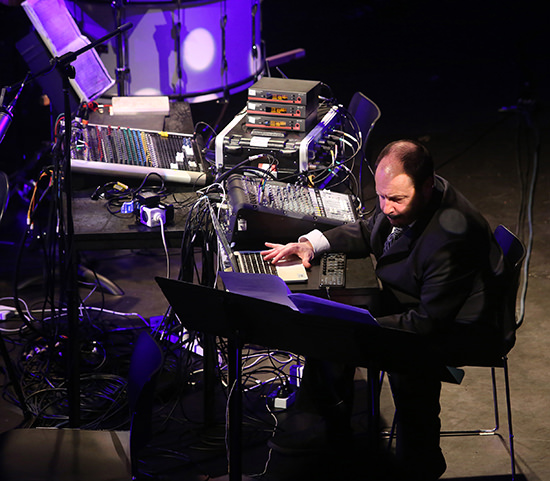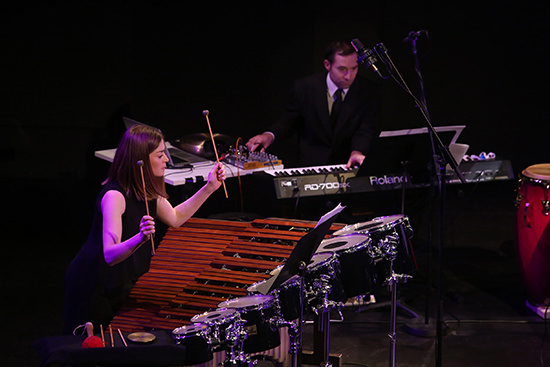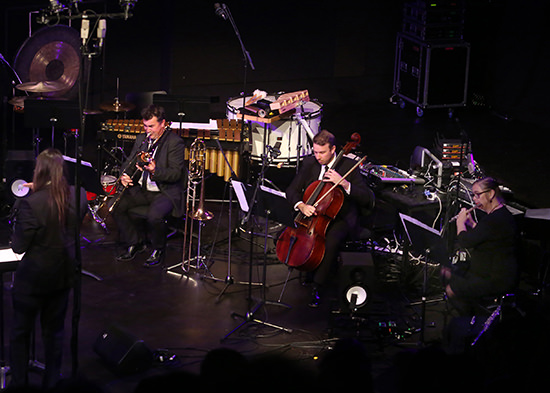Roger Smalley: a new music legacy reinvigorated
Alex Turley: Decibel, Scale Variable, Intermodulations

Lindsay Vickery, Scale Variable, Decibel, Tura New Music
The influence and the legacy of Roger Smalley (1943-2015) are somewhat legendary in Western Australian new music circles. Having emigrated from his European home to Perth in the early 1970s, Smalley spent over 30 years teaching composition at UWA before retiring in 2007; consequently many of his former students now hold senior positions in Western Australian universities and ensembles. As a young composer myself I feel his influence in many ways, despite having never actually met him, since nearly all of my teachers received his tutelage in some form. A notable ex-student is Cat Hope, Artistic Director of Decibel New Music Ensemble, a superstar of Australian new music and curator of Intermodulations, a recent concert in Smalley’s memory featured in TURA’s Scale Variable series.
In pre-show interviews and at the concert, Hope made a point of explaining how Smalley felt his early music inappropriate for Australian audiences, whose distance from the European scene and general inexperience with new music had cultivated a fear of the unknown and relative distaste for electronic music. This concert was, by and large, dedicated to those early European works, which Hope is adamant today’s Perth audience will enjoy—largely due to Smalley’s lasting legacy. She’s not wrong.
Decibel’s concert comprised four smaller chamber works in the first half featuring members of the ensemble in various iterations, and one large-scale work for ensemble and electronics in the second, for which the full ensemble assembled.
First up was Didjeridu (1974), an electroacoustic work for four-channel tape of samples of Australian Indigenous music from the Mornington Peninsula. The characteristic sound of the didjeridu is at first distinct, but gradually distorted beyond recognition, an unconscious—or was it conscious?—comment on the atrocious treatment by whites of Indigenous culture. Appropriating Aboriginal music for a European electro-acoustic work is at best kitsch and at worst racially insensitive. Today composers understand this (mostly) but in previous decades it was hugely popular, an exciting way to combine different musical styles. Doubtless Decibel leader Cat Hope isn’t blind to this, the work functioning more as a window into the past of Australian composition than as contemporary social comment.

Decibel Ensemble, Scale Variable, Tura New Music
Two works for piano and electronics follow: Transformation (1968, revised 1971) and Monody (1971-2). Both use the same electronic technique (ring modulation) to extend the colour palette of the piano and, although composed around the same time, they really sound nothing alike. Transformation is virtuosic and grand, featuring drawn-out sweeps and glissandi and fierce bass notes drawing as much colour as possible from the full range of the piano. It’s almost exhausting to watch guest artist Adam Pinto perform with such depth, from the most intense hammering sounds to suddenly subdued, glassy chords. If this piece is excessive, the second is refined, featuring a sole one-note melody throughout. It’s still extremely technically demanding on the performer but in a different way, as they must play piano with the right hand and control the sine wave frequency with the left, occasionally also moving to triangles and congas. The use of ring modulation in this piece is more melodic and seems to play a more active structural role than in the first. The tonal palette of the composition is unique, almost quirky, as many of the combined frequencies of piano and sine wave don’t conform to equal temperament.
We also hear Impulses (1986), an acoustic work for chamber sextet. This is a rhythmically driven conglomeration of sounds in which percussionist Louise Devenish and cellist Tristen Parr shine as the most assertive performers.
Decibel saves the best for last, assembling onstage to perform the 45-minute-long Zeitebenen. This unique and charismatic work, premiered in Germany in 1973 by Smalley’s new music ensemble Intermodulation, has never been performed in Australia until now, the score spending the past 40 years collecting dust somewhere in the University of Western Australia. It’s immediately obvious that this work draws on influences from each of the four smaller pieces performed earlier, sharing melody with Monody and recalling the electronic soundscape of Didjeridu. Here Smalley’s ideas are given the space they need to be completely aired. The work is politically charged, featuring sounds of warfare alongside those of children, storms, car horns, seagulls and whistles and, at one point, alluding to Tibetan throat singing and featuring colourful conversations between viola, clarinet, vibraphone and piano. This strikingly imaginative piece ends with a definitive thud from Devenish’s bass drum.
Intermodulations was extremely well-received by Perth’s new music audience. The resounding takeaway message was this: let’s not allow Roger Smalley’s music to be forgotten, as has happened to the compositions of so many Australian composers of his generation.

Decibel Ensemble, Scale Variable, Tura New Music
Tura New Music, Scale Variable: Intermodulations, Decibel New Music Ensemble; State Theatre, Centre Studio Underground, Perth, 7 June
Perth-based composer Alex Turley’s City of Ghosts was performed by the Melbourne Symphony Orchestra in the 2016 Metropolis New Music Festival. He was a RealTime-mentored music reviewer at Perth’s 2015 Totally Huge New Music Festival.
RealTime issue #133 June-July 2016






